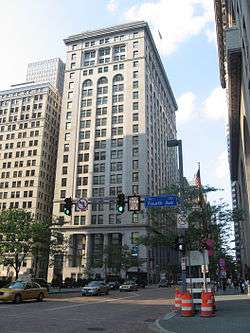Frick Building
| Frick Building | |
|---|---|
 View of the Frick Building along Grant Street | |
| General information | |
| Type | Office |
| Location | 437 Grant Street, Pittsburgh, Pennsylvania |
| Coordinates | 40°26′21″N 79°59′51″W / 40.43917°N 79.99750°WCoordinates: 40°26′21″N 79°59′51″W / 40.43917°N 79.99750°W |
| Construction started | 1901 |
| Completed | March 15, 1902 |
| Opening | March 15, 1902 |
| Cost | $2 million ($58.8 million today) |
| Height | |
| Roof | 330 ft (101 m) |
| Technical details | |
| Floor count | 20 |
| Floor area | 357,474 sq ft (33,210 m2) |
| Lifts/elevators | 11 |
| Design and construction | |
| Architect | D. H. Burnham & Company |
| Developer | Henry Clay Frick |
| Main contractor | George A. Fuller Company |
| Designated | 1974[1] |
The Frick Building is one of the major distinctive and recognizable features of Downtown Pittsburgh, Pennsylvania, United States. The tower was built by and is named for Henry Clay Frick, an industrialist coke producer who created a portfolio of commercial buildings in Pittsburgh. The building is listed on the National Register of Historic Places.
The tower was built directly adjacent to a building owned by his business partner and rival Andrew Carnegie, on the site of Saint Peter Episcopal Church. Frick, who feuded with Carnegie after they split as business associates, had the building designed to be taller than Carnegie's in order to encompass it in constant shadow.[2]
The Frick Building was opened on March 15, 1902 and originally had twenty floors. It was the tallest building in the city at that time.[3] A leveling of the surrounding landscape that was completed in 1912 caused the basement to become the entrance, so some sources credit the building with twenty-one stories. It rises 330 feet (101 m) above Downtown Pittsburgh. Its address is 437 Grant Street, and is also accessible from Forbes and Fifth Avenues.
The building's architect was Daniel H. Burnham of D.H. Burnham & Company, Chicago.[4]
The top floor includes a balcony around the perimeter of the building, a high, handcrafted ceiling, and heavy, elaborate brass door fixtures. Originally, H.C. Frick used it as his personal office and as a meeting place and social club for wealthy industrialists. On the 19th floor was Frick's personal shower. At the time, no other shower had been built that high above ground level, because water could not easily be pumped that high with the technology of the time. The shower, non-functioning, still exists on the 19th floor today. The 20th floor is occupied by COTERIE Company .
Fittingly for a building created for a man who vowed to be a millionaire by age thirty, the lobby features an elegant stained-glass window by John LaFarge, depicting "Fortune and Her Wheel" (1902).[5] The two bronze sentinel lions (1904) in the lobby were created by sculptor Alexander Proctor. A bust of Frick by sculptor Malvina Hoffman (1923) is displayed in the rear lobby, which extends from Forbes to Fifth Avenue.[4]
For a time, the building was home to the headquarters for Frick's family whiskey business, Old Overholt.[6] The headquarters oversaw a network of sales offices around the United States.[6]
On the early morning of July 31, 2017, a 1,500 lbs. piece of the Frick building fell from the top corner, and crashed onto Grant Street below. As a result, Grant Street was closed for several weeks.[7]
References
- ↑ Historic Landmark Plaques 1968-2009 (PDF). Pittsburgh, PA: Pittsburgh History & Landmarks Foundation. 2010. Retrieved 2010-07-02.
- ↑ "The World's Work: A History of Our Time", Volume 14, by Walter Hines Page & Arthur Wilson Page, page 8856.
- ↑ "The Spectator and the Topographical City", by Martin Aurand, page 38.
- 1 2 City of Pittsburgh website.
- ↑ Emporis Corporation description of the Frick Building.
- 1 2 Wondrich, David (12 September 2016). "How Pennsylvania Rye Whiskey Lost Its Way". The Daily Beast. Retrieved 3 October 2016.
- ↑ Hayes-Freeland, Lynne (July 31, 2017). "Grant Street Closed After Granite Stone Falls Off Frick Building". KDKA-TV.
Further reading
- Toker, Franklin (2007). Buildings of Pittsburgh. Pittsburgh: Chicago: Society of Architectural Historians; Santa Fe: Center for American Places ; Charlottesville: In association with the University of Virginia Press. ISBN 0-8139-2650-5.
- Glenn A. Walsh (2001) History of Industrialist, Art Patron, and Philanthropist Henry Clay Frick Retrieved 2005-09-20.
- Mellon Square Map Retrieved 2005-09-20.
- Chris Potter (2005) You Had To Ask Archives Retrieved 2005-09-20.
External links
| Wikimedia Commons has media related to Frick Building. |
| Preceded by Four Gateway Center |
Pittsburgh Skyscrapers by Height 330 feet (101 m) 20 floors |
Succeeded by Wyndham Grand |
| Preceded by Farmers Bank Building |
Pittsburgh Skyscrapers by Year of Completion 1902 |
Succeeded by The Carlyle |
.svg.png)

